九年级英语第十三单元部分教案
- 格式:doc
- 大小:31.00 KB
- 文档页数:5
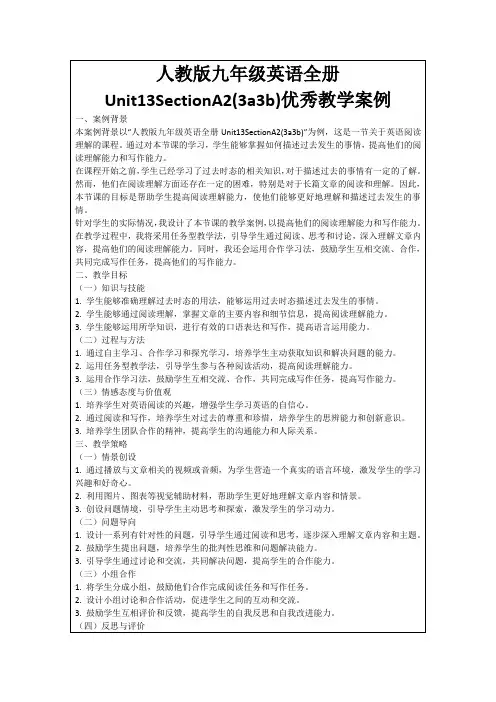
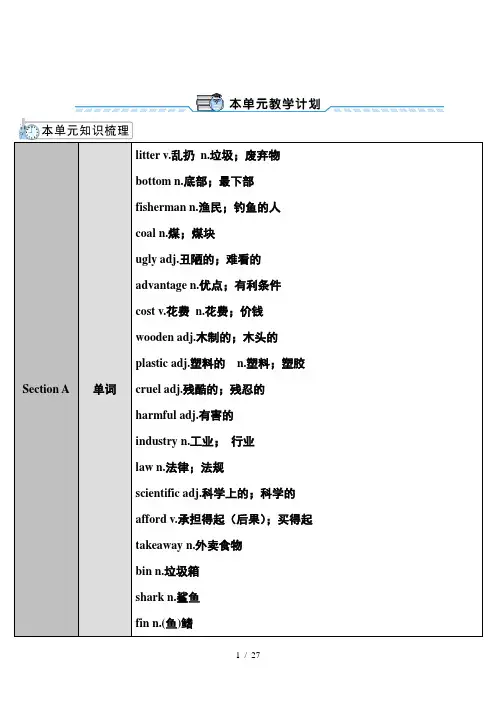
Section A 单词litter v.乱扔n.垃圾;废弃物bottom n.底部;最下部fisherman n.渔民;钓鱼的人coal n.煤;煤块ugly adj.丑陋的;难看的advantage n.优点;有利条件cost v.花费n.花费;价钱wooden adj.木制的;木头的plastic adj.塑料的n.塑料;塑胶cruel adj.残酷的;残忍的harmful adj.有害的industry n.工业;行业law n.法律;法规scientific adj.科学上的;科学的afford v.承担得起(后果);买得起takeaway n.外卖食物bin n.垃圾箱shark n.鲨鱼fin n.(鱼)鳍复习现在进行时、现在完成时和被动语态等的用法。
以“保护环境”为主题,运用本课相关句型与他人展开讨论;能向大家介绍有哪几种污染类型,怎样回收利用废弃物品等。
体会到保护环境的重要性,学会保护大自然、保护地球,从身边的小事做起,号召大家参与到保护环境的行动中来。
【课时建议】本单元建议5课时Section A (1a~2d)……………………………………………………………………………………1课时Section A (3a~4c)……………………………………………………………………………………1课时Section B (1a~1e)……………………………………………………………………………………1课时Section B (2a~2e)……………………………………………………………………………………1课时Section B (3a~3b)……………………………………………………………………………………1课时词汇短语:主要采用多媒体及图片展示法。
基本句子:采用图片展示及交际法(利用多媒体展示两人进行交际时的情景)。
语法:复习现在进行时、现在完成时和被动语态——采用“巧记歌诀”记忆法。
被动语态的用法谁的动作不知道,说出谁做没必要;承受之人需强调,被动语态莫忘了。
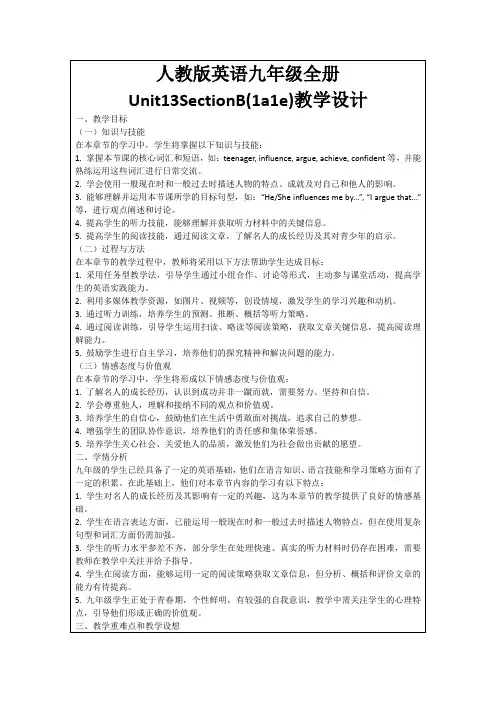
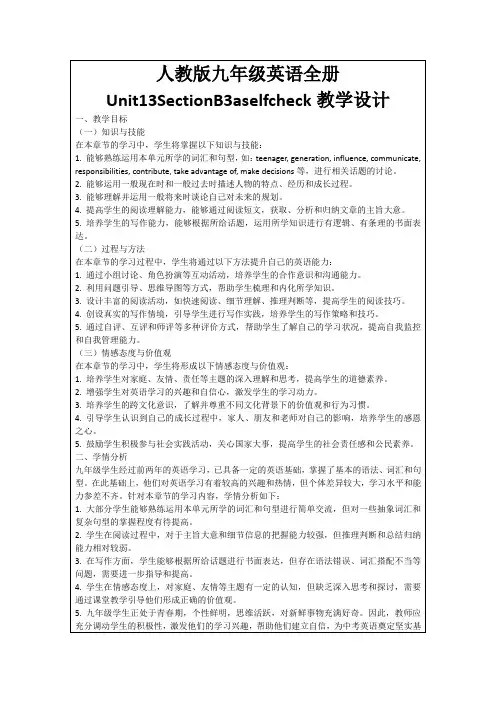
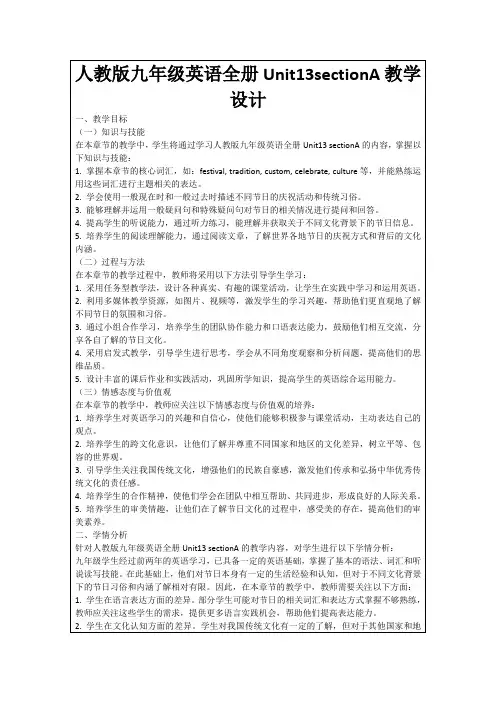

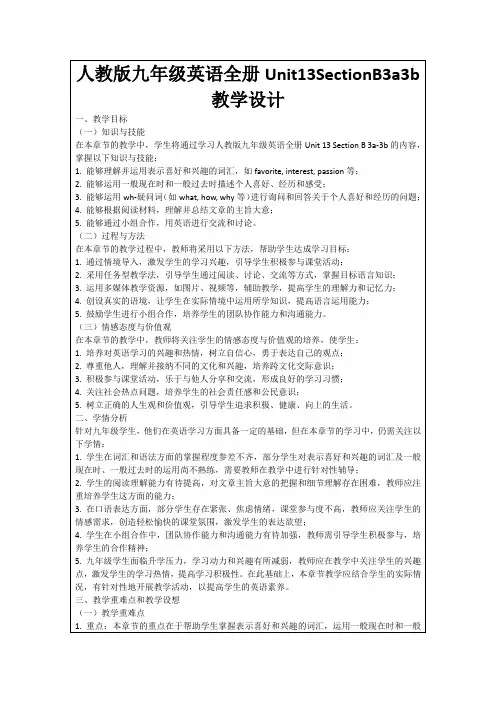
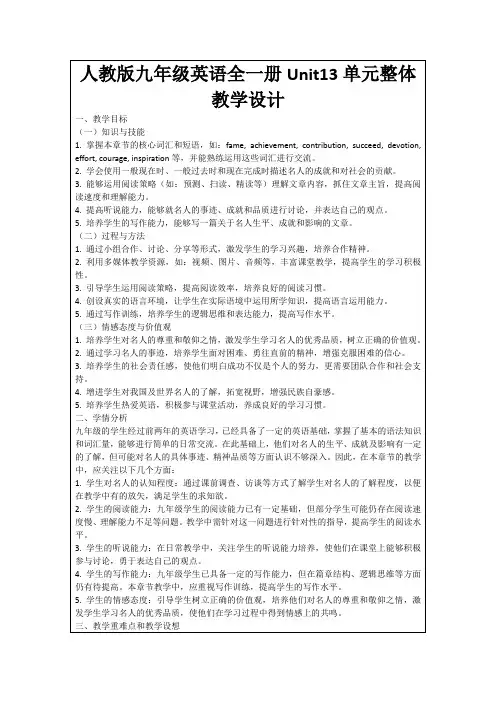
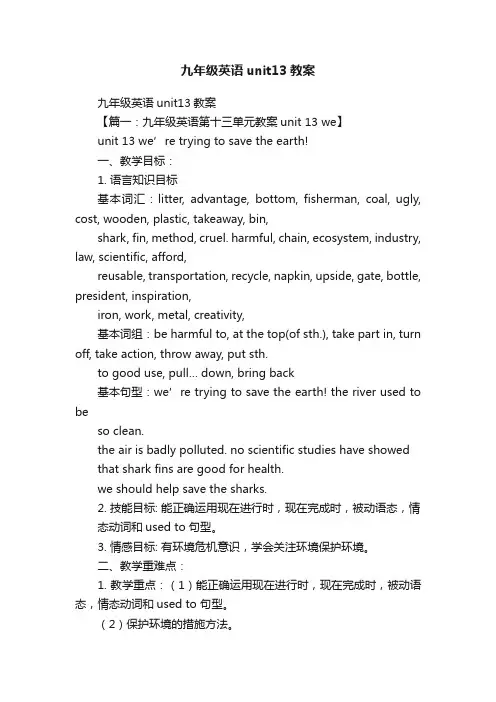
九年级英语unit13教案九年级英语unit13教案【篇一:九年级英语第十三单元教案unit 13 we】unit 13 we’re trying to save the earth!一、教学目标:1. 语言知识目标基本词汇:litter, advantage, bottom, fisherman, coal, ugly, cost, wooden, plastic, takeaway, bin,shark, fin, method, cruel. harmful, chain, ecosystem, industry, law, scientific, afford,reusable, transportation, recycle, napkin, upside, gate, bottle, president, inspiration,iron, work, metal, creativity,基本词组:be harmful to, at the top(of sth.), take part in, turn off, take action, throw away, put sth.to good use, pull… down, bring back基本句型:we’re trying to save the earth! the river used to beso clean.the air is badly polluted. no scientific studies have showed that shark fins are good for health.we should help save the sharks.2. 技能目标: 能正确运用现在进行时,现在完成时,被动语态,情态动词和used to 句型。
3. 情感目标: 有环境危机意识,学会关注环境保护环境。
二、教学重难点:1. 教学重点:(1)能正确运用现在进行时,现在完成时,被动语态,情态动词和used to 句型。
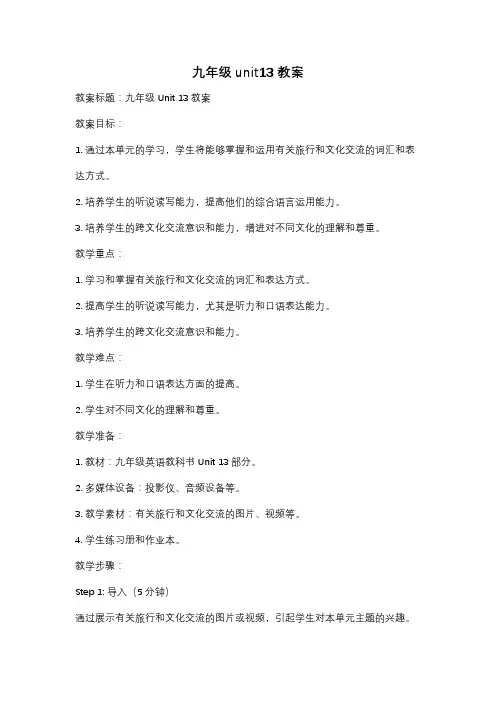
九年级unit13教案教案标题:九年级Unit 13教案教案目标:1. 通过本单元的学习,学生将能够掌握和运用有关旅行和文化交流的词汇和表达方式。
2. 培养学生的听说读写能力,提高他们的综合语言运用能力。
3. 培养学生的跨文化交流意识和能力,增进对不同文化的理解和尊重。
教学重点:1. 学习和掌握有关旅行和文化交流的词汇和表达方式。
2. 提高学生的听说读写能力,尤其是听力和口语表达能力。
3. 培养学生的跨文化交流意识和能力。
教学难点:1. 学生在听力和口语表达方面的提高。
2. 学生对不同文化的理解和尊重。
教学准备:1. 教材:九年级英语教科书Unit 13部分。
2. 多媒体设备:投影仪、音频设备等。
3. 教学素材:有关旅行和文化交流的图片、视频等。
4. 学生练习册和作业本。
教学步骤:Step 1: 导入(5分钟)通过展示有关旅行和文化交流的图片或视频,引起学生对本单元主题的兴趣。
可以提问学生是否喜欢旅行、是否有过文化交流的经历等,激发学生的思考和参与。
Step 2: 预习(10分钟)让学生预习本单元的课文和词汇,了解本单元的主要内容和目标。
可以让学生自主阅读课文或进行小组讨论,然后提问学生他们对本单元的预期和期望。
Step 3: 听说训练(20分钟)播放本单元的听力材料,让学生听取关键信息并回答问题。
可以设计一些听力练习,如听取旅行计划或文化交流活动的对话,然后让学生进行口头表达。
可以采用小组讨论、角色扮演等形式,鼓励学生积极参与。
Step 4: 读写训练(20分钟)让学生阅读本单元的课文,并进行相关的阅读理解练习。
可以设计一些填空、选择题或简答题,帮助学生理解课文内容和提高阅读能力。
同时,让学生进行写作练习,如写一篇关于自己旅行经历或文化交流活动的短文,培养他们的写作能力。
Step 5: 综合训练(15分钟)设计一些综合性的练习,让学生综合运用本单元所学的知识和技能。
可以设计一些情景对话、角色扮演或小组讨论,让学生在实际情境中运用所学的词汇和表达方式。

Unit 13 We’re trying to save the earth!Section A 1 (2a-2d) 安乐初级中学苏奇上一、教学目标:1. 语言知识目标基本词汇:litter, advantage, bottom, fisherman, coal, ugly, cost, wooden, plastic, takeaway, bin, shark, fin, method, cruel.Harmful, chain, ecosystem, industry, law, scientific, afford,reusable, transportation, recycle, napkin, upside, gate,bottle, president, inspiration, iron, work, metal,creativity,基本词组:be harmful to, at the top(of sth.), take part in, turn off, take action, throw away, put sth. to good use, pull… down,bring back基本句型:We’re trying to save the earth!The river used to be so clean.The air is badly polluted.No scientific studies have showed that shark fins are good for health.We should help save the sharks.2. 技能目标: 能正确运用现在进行时,现在完成时,被动语态,情态动词和usedto 句型。
3. 情感目标:有环境危机意识,学会关注环境保护环境。
二、教学重难点:1. 教学重点:(1)能正确运用现在进行时,现在完成时,被动语态,情态动词和used to 句型。
(2)保护环境的措施方法。
2. 教学难点:能正确运用现在进行时,现在完成时,被动语态,情态动词和used to 句型。
三、教学步骤:VI. Listening1. 2a Listen to the interview. Circle the kinds of pollution that Jason and Susan talk about.A. land pollutionB. air pollutionC. noise pollutionD. water pollutionKeys: B A2. 2b Listen again and complete the sentences.1) The air is badly polluted because there are ___________ on the road these days.2) Factories that burn coal also ________ the air with a lot of black smoke.3) There is also too much rubbish and waste. People _________________ things every day.4) People are also littering in ______________ like parks. This is turning beautiful places into ugly (丑陋) ones.Keys: more cars pollute are throwing away public places3. Listen and answer the questions.1) Who is the interviewer talking to2) What are they talking3) What other problems do they seeKeys: Susan and Jason.The environmental problems.There’s too much rubbish and waste in the streets.VII. Practice (2c)Use the information in 2a and 2b to role-play conversations between Jason and Susan.Jason: The air has become really pollute d around here. I’m getting very worried.Susan: Yes, I used to be able to see stars in the sky.Jason: The problem is that…VIII. DiscussionAsk students what we should do to save the earth. Help students answer, turn off thelights when you leave a room; stop riding in cars; stop using paper towels or napkins; recycle books and paper.IX. Reading1. Read 2d and complete the chart.2. Role-play the conversation.Interviewer: Jason and Susan, what are your ideas for solving these problemsJason: Well, to cut down air pollution, we should take the bus or subway instead of driving.Susan: Yeah, or ride a bike. There are other advantages (优点) of bike riding. It’s good for health and it doesn’t cost (花费) anything! Interviewer: Great ideas! What about waste pollutionSusan: Mmm, I think simple things like bringing a bag to go shopping can help. I started doing that a year ago.Jason: Me, too. Also, I never take wooden chopsticks or plastic (塑料) forks when I buy takeaway (外卖食品) food. I use the ones at home. Susan: And remember to throw rubbish in the bins and keep public places clean and beautiful for everyone.Interviewer: So together, our actions can make a difference and lead toa better future!X. Summary and language points1. This is turning beautiful places into ugly ones.turn… into… 把……变成……. The icy rain seemed like to turn into snow.渐渐地冻雨又变成雪花的模样。
2. It’s good for health and it doesn’t cost anything!cost v. 花费;使付出指花费金钱,主语通常是物。
cost的过去式和过去分词均为cost。
. The new shirt cost Mr Wang 200 yuan. 王先生花了200元买了新衬衫。
How much does the new computer cost 新电脑花了多少钱take, spend, pay & costtake,spend,pay和cost都可以表示“花费”,但它们的用法各有不同。
1) take多表示花费时间,常用于It takes sb. some time to do sth.这一句型中,其中it作形式主语。
. It usually takes me 40 minutes to cook the dinner.2) spend多表示花费时间和金钱,主语通常是人,常用于sb. spend(s) some time / money on sth.和sb. spend(s) some time / money (in) doing sth.两种句型。
. David spent 2,000 yuan on the new machine.My father spends an hour (in) watching the news on TV every day.3) pay多表示花费金钱,主语通常是人,常用于sb. pay(s) some money forsth.句型。
. Tommy paid 20 yuan for his breakfast yesterday.4) cost多表示花费金钱,主语通常是物,常用于sth. cost(s) (sb.) somemoney. 句型。
. The new dress cost Linda 88 yuan.根据句意用take, spend, pay或cost的适当形式填空。
1) That new car ________ them lots of money.2) Mona __________ 50 yuan on the books just now.3) It usually _______ me an hour to do my homework.4) You should __________ some time practising your pronunciation.5) My brother _______ 6, 000 yuan for the new computer yesterday. Keys cost spent takes spend paid3. So together, our actions can make a difference and lead to a better future!make a difference (to…)表示(对……)产生影响或作用. Do you think his words would make any difference to the final decision 你认为他的话会对最后的决定产生影响吗The new teacher always encourages little Tom. This has made a big differenceto him.新来的老师总是鼓励小汤姆,这对他影响很大。